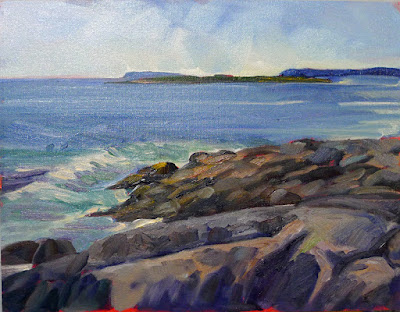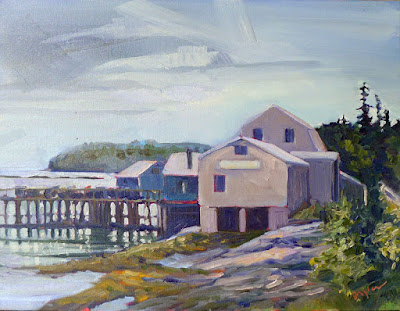Sometimes you need a hair of the dog what bit you.
 |
| Sunset near Clark Island, by Carol L. Douglas |
There are very few people I would invite over when my house isn’t clean. Bobbi Heath is one of them. She kindly brought dinner. My cough has lingered and I was downright crabby. I wasn’t sure reality was any place I wanted to be dragged back to. She ignored all that, and I’m far better for it.
The best place for rolling ocean breakers near me is in St. George, which is south of Penobscot and its canopy of islands. The tide was rising, throwing up a good screen of spray. I had about three hours where it would be in roughly the same position as it rose, paused and started to drop again.
That gave me time to approach the business of painting in a gingerly way. I did a fast watercolor sketch, which seemed like less of a commitment. The surf and the wind died as the tide turned.
 |
| Off Marshall Point, watercolor, by Carol L. Douglas |
When a wave’s height reaches a point of instability, it breaks. Part of its energy is converted to turbulence, which we see as foam. How this happens varies depending on what’s hidden below the water’s surface. If the ocean floor slopes gradually up, the wave steepens until the top becomes unstable. Whitewater spills down the face of the wave. This results in long, slow breakers.
We don’t have a gradual seafloor in Maine. Here, breakers trip and collapse over ledges and sandbars. These breakers are fast and violent, releasing their energy much more quickly than a gentle spilling wave.
Being close to the
Bay of Fundy, we also have a relatively high tide. That means a lot can change in an hour. At high tide, there was nothing for my particular waves to get excited about. They ended their careers in a gentle roll onto the rocks. Still, that’s as interesting as the collision of breakers, and so I painted that in oils.
 |
| Rolling, not breaking, by Carol L. Douglas |
I was most interested in the light conditions, anyway. I like a strong, raking sidelight, which autumn provides here in the north. Bobbi introduced me to a new term for this:
contre-jour. That’s just old-fashioned backlighting in party clothes. I found it, almost in excess.
Already, the sun makes no effort to reach the top of the vault of heaven, dragging itself around the sky’s perimeter like an old man. It sparkles like a jewel on the water and it darn near blinds the painter. Still, every old farmhouse shone like an architectural jewel, and every plant and tree was picked out in beautiful gold. It’s the most beautiful time of the year in the northeast.
 |
| I’m no birder, and I don’t recognize these fellows. They’re about the size of songbirds. |
We each did a second painting, down the road in quiet South Thomaston. There was little company except flying things—some gulls, some wee water birds, and several pounds of mosquitoes per square yard.
Sooner than I expected, it was evening and my truncated workweek was done. On Saturday, I had coffee with New Brunswick artists Alan and Helen Spinney. On Sunday, I clambered around a steep piece of hillside in Belfast. Today I feel almost normal. Thanks, Bobbi.















